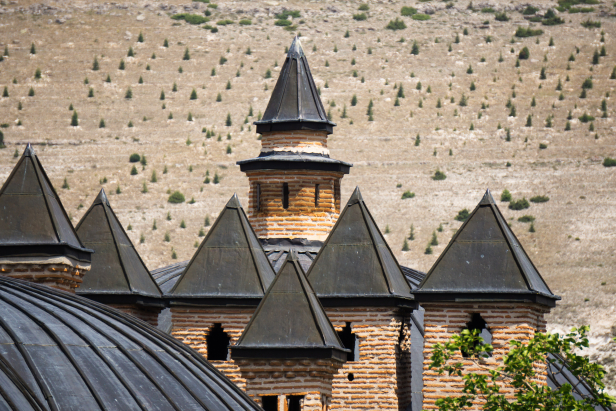Seyitgazi Tomb and Religious Complex
Seyitgazi Türbe ve Külliyesi
/ By Josh
Cost: Free
Great for: Umayyad History, Seljuk History, Islamic History, People who love to run off with princesses
Looking upwards from the dusty town of Seyitgazi, one cannot miss the clusters of pointed chimneys and leaden domes rising from tall stone walls built high above on a hilltop. This structure is a 13th century religious complex built around the tomb and legend of the warrior-saint Seyit Battal Gazi who was a commander in the Umayyad armies that conquered much of Anatolia.
The complex is arranged in a roughly U-shaped configuration. When you first pass through the lower gate and into the courtyard the tomb of Seyit Battal Gazi, the hero warrior-poet after whom the complex is named, will be on your left under the largest of the complex’s many domes. The octagonal mausoleum is one of the largest of its type in Turkey, possibly to make room for the seven-meter-long coffin of finely carved wood, a fitting coffin for one who was said to have been a nearly 20 foot giant! Next to the incredibly long coffin is the much smaller, though beautifully ornate coffin of his wife, a Byzantine princess that is said to have fallen in love with the Arab warrior (some accounts even have him whisking her away from Istanbul’s Maiden’s Tower).
The mausoleum is attached now to a domed mosque, though the odd windows and doorways low in the floor suggest that this part of the complex has changed multiple times over the centuries.

Across from the tomb and mosque is a row of large domed rooms including a massive cook house, bakery, and a pair of rooms set aside for religious ceremonies.
In the middle of the courtyard is a rather unusual sight. A large marble sarcophagus has been converted into a water fountain for ablutions (ceremonial washing before prayers). While undoubtedly clean, the idea of a box used to hold dead bodies as a source of purifying water seems to break the symbolism.
To the left of the unusual ablution fountain is one of the most original buildings in the complex. Its entrance in on the far side, away from the courtyard and was designed primarily as a madrasah, or religious school and houses the tomb of Ümmühan Hatun (wife of Sultan Giyaseddin Keyhüsrev I) who first commissioned the building of the complex.
NOTE: There are a number of sources that state that the complex was built around a Byzantine church or monastery, though they are not clear which building it is or if the building still stands. While there is no structure here today that immediately looks like a church, the complex is rather confused in layout and has been re-built and renovated many times over the centuries.

During the 8th century the armies of the Arab Umayyad Empire were expanding into Anatolia, slowly driving the Christian Byzantines westward toward the capital city of Constantinople. Seyit Battal Gazi (Originally Seyit Abdullah al-Battal) was born in the last years of the 7th century in Battal Gazi, a city that later took his name. Battal Gazi went on to become a military commander whose successes gave rise to legends hundreds of years after his death at the battle of Akroinon (near present day Afyon) in 740.
Later Seljuk conquerors and settlers looked to Battal Gazi as a religious hero and in 1208, Ümmühan Hatun (wife of Sultan Giyaseddin Keyhüsrev I) commissioned the building of a Türbe (a shrine-tomb) and religious complex, to be built on top of the hill. Over the centuries it expanded and in 1511 was greatly restored by Ottoman Sultan Beyazid II into the rambling form we see today.

The complex became a center of the Bektaşi order of dervishes (monk-like mystics), who used the complex until 1920 when the all the dervish orders were officially outlawed. Many Bektashi graves can be found throughout the complex.
The Seyitgazi complex was built on the ruins of a Byzantine city known as Nakoleia, whose scant remains can be found in the area. There are cave tombs in the hills around the complex as well as a number of marble baptistries in the grounds of the complex. If you look closely you’ll notice white marble stones with inscriptions and patterns left over from the roman/Byzantine period and used in the walls of buildings.

How To Get There
Public Transport
There is public transit connecting the town of Seyitgazi to the city of Eskişehir leaving regularly though exactly how frequently is a mystery as the government website is an absolute mess.
Car
Leaving the city of Eskişehir drive south-west on Zümrüt Boulevard/Highway D665 for 37 kilometers. This will bring you directly to the town of Seyitgazi. The highway takes a sharp right turn in the center of the town, go straight through, leaving the highway. Follow this for 300 meters then turn right on Türbe street, and follow this up to the unmistakable complex.
For more about car rental and driving in Turkey make sure to read our full drivers guide.
Where To Stay
Unfortunately, there are no hotel options in Seyitgazi itself. The city of Eskişehir is 40 kms away and has plenty of hotel options. Gazlıgöl (71 kms) and The City of Afyon (88 kms) are famous for their thermal hotspring hotels.
Other Tips
Seyitgazi is in the south of Eskişehir province and on the edge of the Phrygian Valley region; full of fairy chimneys, cave settlements, shrines, and cave churches.
Have any tips or info to add? Spot any mistakes? We’d love to hear about it.
